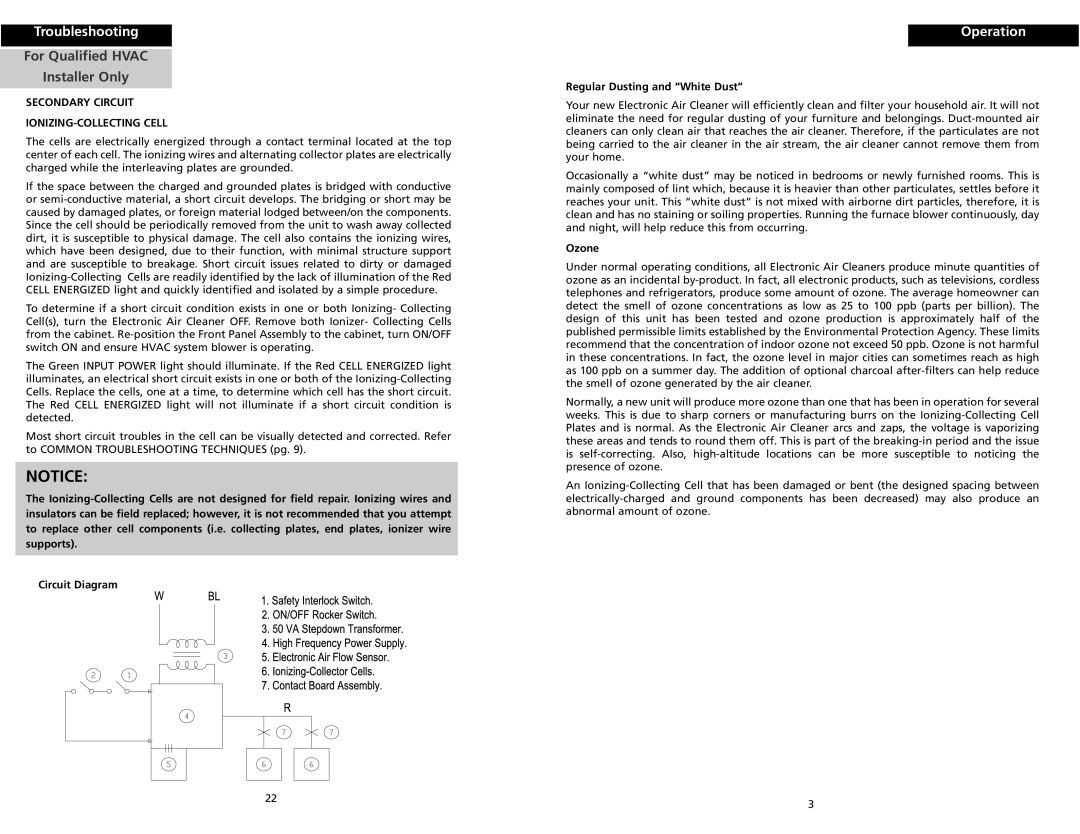Troubleshooting
For Qualified HVAC
Installer Only
SECONDARY CIRCUIT
IONIZING-COLLECTING CELL
The cells are electrically energized through a contact terminal located at the top center of each cell. The ionizing wires and alternating collector plates are electrically charged while the interleaving plates are grounded.
If the space between the charged and grounded plates is bridged with conductive or semi-conductive material, a short circuit develops. The bridging or short may be caused by damaged plates, or foreign material lodged between/on the components. Since the cell should be periodically removed from the unit to wash away collected dirt, it is susceptible to physical damage. The cell also contains the ionizing wires, which have been designed, due to their function, with minimal structure support and are susceptible to breakage. Short circuit issues related to dirty or damaged Ionizing-Collecting Cells are readily identified by the lack of illumination of the Red CELL ENERGIZED light and quickly identified and isolated by a simple procedure.
To determine if a short circuit condition exists in one or both Ionizing- Collecting Cell(s), turn the Electronic Air Cleaner OFF. Remove both Ionizer- Collecting Cells from the cabinet. Re-position the Front Panel Assembly to the cabinet, turn ON/OFF switch ON and ensure HVAC system blower is operating.
The Green INPUT POWER light should illuminate. If the Red CELL ENERGIZED light illuminates, an electrical short circuit exists in one or both of the Ionizing-Collecting Cells. Replace the cells, one at a time, to determine which cell has the short circuit. The Red CELL ENERGIZED light will not illuminate if a short circuit condition is detected.
Most short circuit troubles in the cell can be visually detected and corrected. Refer to COMMON TROUBLESHOOTING TECHNIQUES (pg. 9).
NOTICE:
The Ionizing-Collecting Cells are not designed for field repair. Ionizing wires and insulators can be field replaced; however, it is not recommended that you attempt to replace other cell components (i.e. collecting plates, end plates, ionizer wire supports).
Circuit Diagram
Operation
Regular Dusting and “White Dust”
Your new Electronic Air Cleaner will efficiently clean and filter your household air. It will not eliminate the need for regular dusting of your furniture and belongings. Duct-mounted air cleaners can only clean air that reaches the air cleaner. Therefore, if the particulates are not being carried to the air cleaner in the air stream, the air cleaner cannot remove them from your home.
Occasionally a “white dust” may be noticed in bedrooms or newly furnished rooms. This is mainly composed of lint which, because it is heavier than other particulates, settles before it reaches your unit. This “white dust” is not mixed with airborne dirt particles, therefore, it is clean and has no staining or soiling properties. Running the furnace blower continuously, day and night, will help reduce this from occurring.
Ozone
Under normal operating conditions, all Electronic Air Cleaners produce minute quantities of ozone as an incidental by-product. In fact, all electronic products, such as televisions, cordless telephones and refrigerators, produce some amount of ozone. The average homeowner can detect the smell of ozone concentrations as low as 25 to 100 ppb (parts per billion). The design of this unit has been tested and ozone production is approximately half of the published permissible limits established by the Environmental Protection Agency. These limits recommend that the concentration of indoor ozone not exceed 50 ppb. Ozone is not harmful in these concentrations. In fact, the ozone level in major cities can sometimes reach as high as 100 ppb on a summer day. The addition of optional charcoal after-filters can help reduce the smell of ozone generated by the air cleaner.
Normally, a new unit will produce more ozone than one that has been in operation for several weeks. This is due to sharp corners or manufacturing burrs on the Ionizing-Collecting Cell Plates and is normal. As the Electronic Air Cleaner arcs and zaps, the voltage is vaporizing these areas and tends to round them off. This is part of the breaking-in period and the issue is self-correcting. Also, high-altitude locations can be more susceptible to noticing the presence of ozone.
An Ionizing-Collecting Cell that has been damaged or bent (the designed spacing between electrically-charged and ground components has been decreased) may also produce an abnormal amount of ozone.

